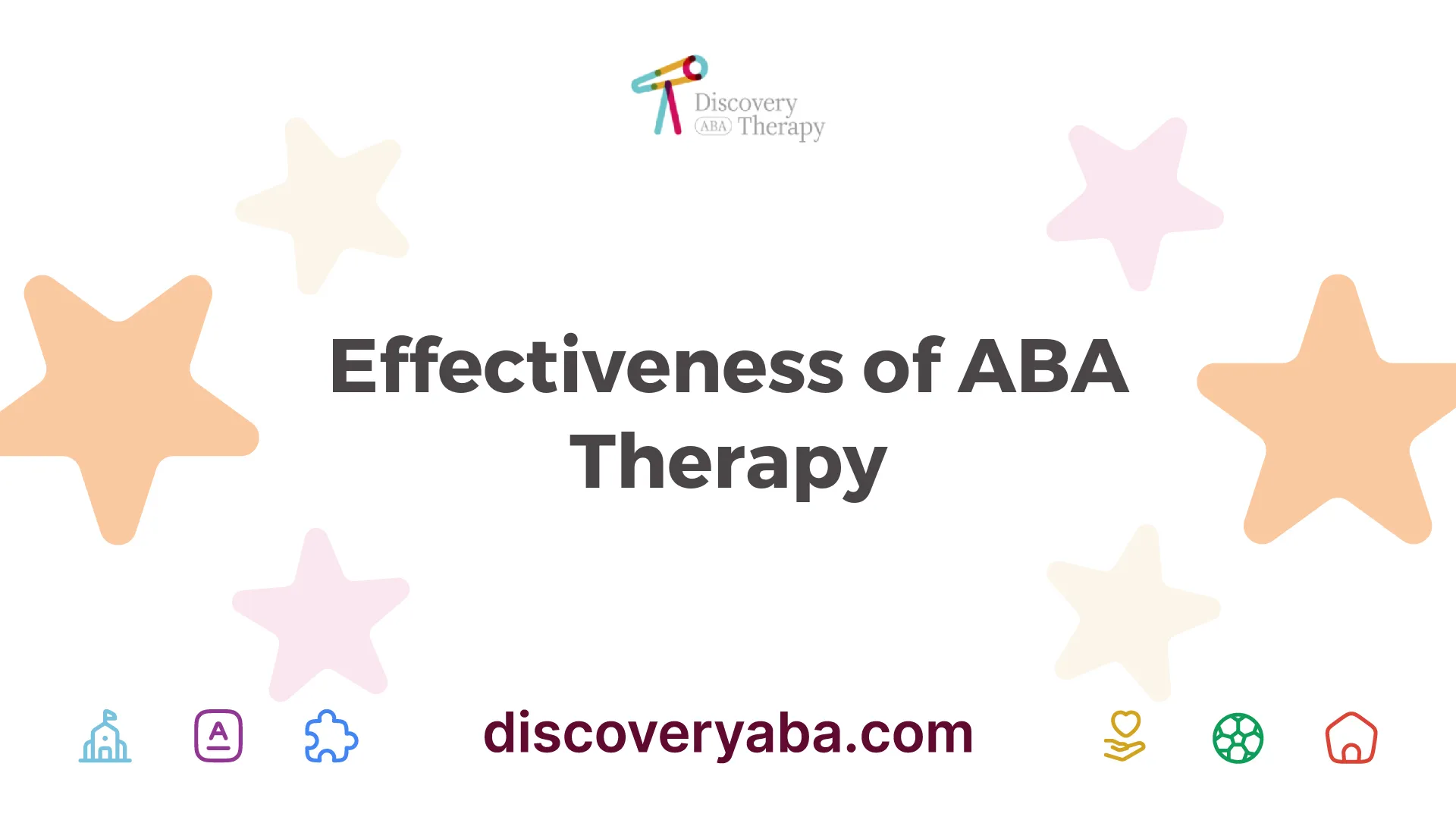ABA for Autism and ADHD
Explore ABA for autism and ADHD: effective techniques, benefits, and what parents need to know.

Understanding ABA Therapy
Applied Behavior Analysis (ABA) therapy focuses on helping children on the autism spectrum develop essential social and emotional skills. It achieves this by implementing interventions grounded in learning theory principles. Below, the core principles and various benefits associated with ABA therapy are discussed.
Principles of ABA Therapy
The backbone of ABA therapy is the application of positive reinforcement, which involves rewarding children for successfully completing tasks. By offering incentives for correct actions, the likelihood of these desired behaviors being repeated increases over time [1]. Additionally, ABA employs behavior modification techniques to address challenging behaviors commonly observed in autism, such as self-injury, aggression, and repetitive actions.

The following table outlines key principles of ABA therapy:
PrincipleDescriptionPositive ReinforcementRewards are given for desired behaviors, increasing the chances of those behaviors being repeated.Behavior ModificationTechniques used to alter problematic behaviors effectively and constructively.Individualized GoalsGoals are tailored to each child's unique needs, ensuring more effective outcomes.Continuous AssessmentRegular monitoring and adjustment of strategies to meet evolving needs.
Benefits of ABA Therapy
ABA therapy has a range of benefits, particularly for children with autism and ADHD. It effectively addresses specific behavioral challenges while fostering skill development in essential areas, such as social interactions and communication. Some notable benefits of ABA therapy include:
Research supports these benefits, with a meta-analysis indicating positive outcomes in areas such as socialization, communication, and expressive language in children receiving ABA therapy [6].
By understanding the principles and benefits of ABA therapy, parents and caregivers can make informed decisions regarding the best interventions for children with autism and ADHD. For further exploration of specific techniques, consider reviewing topics like managing tantrums with aba and aba for daily routines in autism.
ABA Therapy Techniques
Applied Behavior Analysis (ABA) therapy employs various techniques to support individuals with autism and ADHD. Among these methods, positive reinforcement and behavioral interventions stand out for their effectiveness in promoting desirable behaviors.
Positive Reinforcement
Positive reinforcement is a fundamental technique in ABA therapy. This approach involves providing rewards when a child successfully completes a task or exhibits desired behaviors. Over time, this practice effectively increases the likelihood that these behaviors will be repeated. For example, if a child successfully follows a direction, they might receive praise, a small treat, or extra playtime as a reward. This technique helps children understand the relationship between their positive actions and the outcomes, encouraging more of those actions in the future.
The effectiveness of positive reinforcement can be summarized as follows:
BenefitDescriptionIncreases desired behaviorsEncourages repetition of positive actionsBuilds self-esteemRewards boost confidence and motivationShapes behaviors over timeGradual progression towards achieving complex tasks
Behavioral Interventions
Behavioral interventions within ABA therapy are designed to address specific behaviors by targeting their functions. ABA principles focus on four primary functions of behavior: escape, access, attention, and automatic reinforcement. Understanding these functions helps create effective intervention plans tailored to individual needs [7].
Common behavioral interventions include:
These interventions collectively contribute to a child’s understanding of the connection between their behaviors and the consequences of those actions, leading to improved language development, social skills, and daily living skills. A comprehensive overview of ABA impacts indicates significant positive changes in several areas for children with autism spectrum disorders [8].
By implementing techniques like positive reinforcement and various behavioral interventions, ABA therapy serves as a valuable tool for parents and caregivers striving to support the development and well-being of children with autism or ADHD. For further exploration of specific areas within ABA, consider reading about addressing echolalia with ABA or managing tantrums with ABA.

Effectiveness of ABA Therapy
Applying ABA therapy for individuals with Autism and ADHD has demonstrated a variety of positive outcomes. These results have been validated through extensive research and clinical study.
Outcomes of ABA Therapy
Intensive and long-term ABA therapy, involving 25 to 40 hours per week for one to three years, has shown numerous benefits. Participants typically experience improvements in social skills, behavior modifications, and enhanced language capabilities.
OutcomePercentage of ImprovementReached normal intellectual functioning (UCLA Young Autism Project)47%Significant improvement after 4 years48%Participants showing overall progress after intensive therapy (1987 study)90%
A crucial study involving children diagnosed with Autism Spectrum Disorder (ASD) indicated dramatic outcomes, with 47% of attendees achieving functional levels comparable to their peers compared to just 2% in a control group. These findings highlight the efficacy of consistent and comprehensive ABA interventions.
Research Findings
Research across multiple studies consistently finds benefits of ABA therapy. A meta-analysis discovered that comprehensive ABA strategies positively influenced language advancement, intellectual capability, daily living skills, and social functioning in children with ASD when compared to groups that did not receive such interventions [8].
Additionally, a 2012 analysis involving 14 randomized control trials with 555 participants indicated a small to medium success rate depending on specific improvement targets. These rates affirm the overall effectiveness of ABA therapy, particularly when tailored for children early in life and structured as long-term, comprehensive plans.
The benefits of ABA therapy are not limited to cognitive skills. Studies suggest that ABA methodologies can significantly improve emotional growth and interactions with peers, helping manage behaviors associated with ADHD by emphasizing routines and positive reinforcement [2].
With a broader understanding of how ABA can lead to meaningful changes, parents and caregivers can make more informed decisions regarding intervention options for their loved ones. For further insights into applying ABA techniques, check out resources such as aba for managing transitions and managing tantrums with aba.
Considerations for ABA Therapy
When implementing Applied Behavior Analysis (ABA) therapy, there are key considerations that caregivers and parents should take into account to ensure the most effective support for individuals with Autism Spectrum Disorder (ASD) and Attention Deficit Hyperactivity Disorder (ADHD).
Individualized Treatment Plans
ABA therapy is highly personalized, as it is tailored to meet the unique needs and characteristics of each individual. Treatment plans are flexible and can adapt to various behavioral concerns, making ABA effective not only for children but also for adults with autism and other behavioral disorders.
Individualized treatment plans include:
The collaborative care model for autism treatment emphasizes participation from mental health professionals, caregivers, educators, and healthcare providers. This unified approach enhances the likelihood of positive outcomes and improves the quality of life for individuals with autism.
Age and Intervention Timing
The age at which intervention begins plays a significant role in the effectiveness of ABA therapy. Research shows that early diagnosis and intervention for autism spectrum disorder (ASD) are crucial for promoting overall well-being and improving developmental outcomes. Studies indicate beneficial effects when intervention occurs during the preschool years or earlier [9].
For effective treatment planning, consider:
By recognizing the importance of individualized treatment plans and the timing of interventions, caregivers can enhance the effectiveness of ABA therapy for individuals with autism and ADHD, thereby fostering their success in social and adaptive skills.
Criticisms of ABA Therapy
While ABA therapy is widely recognized and praised for its effectiveness in treating autism, it is not without criticisms and concerns from various individuals and professionals. Understanding these criticisms can provide valuable insights for parents and caregivers considering this form of intervention.
Concerns and Criticisms
Some notable criticisms of ABA therapy include the intensity and duration of treatment sessions, which can place a significant financial burden on families. Many parents find it challenging to manage the costs associated with long-term therapy. Additionally, there are ethical concerns regarding the treatment practices. Critics argue that some techniques may be perceived as overly controlling or manipulative, raising issues about consent and emotional well-being [10].
A summary of specific concerns regarding ABA therapy is outlined in the table below:
ConcernDescriptionIntensity of TreatmentOften requires many hours of therapy weekly, which can be overwhelming for children and families.Financial BurdenLong-term treatment can be costly, affecting family finances.Ethical IssuesSome methods may seem controlling, leading to concerns about autonomy and emotional impact.Holistic ApproachCritics suggest that ABA may neglect the emotional or psychological aspects of autism.
Evolving Practices
In response to these criticisms, ABA therapy practices are evolving. Modern approaches increasingly emphasize a more holistic view of autism, focusing not only on behavioral changes but also on emotional well-being and personal development. Programs are being designed to address individual needs, promoting a collaborative approach between therapists, parents, and the individuals receiving care.
Recent studies underscore the importance of individualized treatment plans that consider each individual's unique strengths and challenges. For example, research indicates that while ABA therapy shows effective outcomes in areas like socialization, communication, and expressive language, there can be limitations in addressing general autism symptoms [6]. This evolving practice looks to balance structured behavioral interventions with a focus on emotional growth, social interactions, and personal independence.
Parents and caregivers should be aware of the criticisms and evolving nature of ABA therapy. Exploring different approaches, including ABA for managing transitions, improving peer interactions, and addressing specific issues, can lead to a more comprehensive understanding of how ABA can fit into the broader context of autism care. For details on more targeted interventions, consider resources like addressing echolalia with ABA or reducing anxiety through ABA.
Comprehensive Autism Care
Collaborative Approach
A collaborative care model is essential in providing effective support for individuals with autism spectrum disorder (ASD). This approach emphasizes the involvement of a diverse team of professionals, including psychologists, psychiatrists, speech-language pathologists, occupational therapists, and special education teachers. This interdisciplinary teamwork ensures that care is comprehensive and tailored to the unique needs of individuals and their families.
By promoting active participation among mental health professionals, caregivers, educators, and healthcare providers, this collaborative strategy maximizes the potential for positive outcomes. Each professional brings specialized knowledge that contributes to creating an effective treatment plan, addressing various aspects of the individual's development. A coordinated approach leads to a better quality of life for individuals with autism, as it combines resources and perspectives to create a holistic treatment experience.
Multidisciplinary Care Team
The establishment of a multidisciplinary care team enhances the treatment experience for individuals with autism. A team can provide insights into different developmental areas, ensuring that interventions are well-rounded and effective. Below is a breakdown of key professionals typically involved in a multidisciplinary team for autism care:
Professional RoleFocus AreaPsychologistsMental health assessments and therapiesPsychiatristsMedication management and psychiatric careSpeech-Language PathologistsCommunication skills and language developmentOccupational TherapistsDaily living skills and sensory integrationSpecial Education TeachersAcademic support and educational strategies
This array of professionals collaborates to develop personalized strategies that support the unique strengths and abilities of individuals with autism. By recognizing individual differences, team members can create tailored treatment plans that foster growth and development across various domains [9].
To further enhance the benefits of these treatments, integrating approaches like aba for daily routines in autism and improving peer interactions with aba can be invaluable. This ensures that care is not only systematic but also adaptable to individual needs while promoting a healthy overall development process.
References
[2]:
[3]:
[4]:
[5]:
[6]:
[7]:
[8]:
[9]:
[10]:
[11]:
Does Your Child Have An Autism Diagnosis?
Learn More About How ABA Therapy Can Help
Find More Articles
Contact us
North Carolina, Nevada, Utah, Virginia
New Hampshire, Maine
Arizona, Colorado, Georgia, New Mexico, Oklahoma, Texas
.avif)




































































































